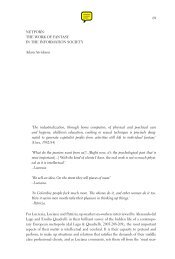Nakamura, Digitizing Race, Introduction, chapter 5, Epilogue
Nakamura, Digitizing Race, Introduction, chapter 5, Epilogue
Nakamura, Digitizing Race, Introduction, chapter 5, Epilogue
Create successful ePaper yourself
Turn your PDF publications into a flip-book with our unique Google optimized e-Paper software.
124 The Social Optics of <strong>Race</strong><br />
the other characters possess this ability.” Echoing the visual setup of Minority<br />
Report, Foster notes: “The [Matrix] films then define a new ideology of<br />
transparency, associated not with the unthinking acceptance of surface appearances,<br />
but with the ability to see through such realistic illusions. While<br />
immersion in the illusion naturalizes appearances, Neo’s ability to perceive<br />
their constructedness naturalizes that ability as a function of the unaided<br />
critical faculties of the human mind, independent of any technological<br />
prosthesis or interface.” 50 Wood argues that the scenes depicting the “detecting<br />
wall” are demonstrations of interactive media that have more in common<br />
with digital games, MUDs and MOOs, and other immersive environments<br />
that are more frequently studied. Indeed, if photography as a mode of identifying<br />
and categorizing criminals was characteristic of the early twentieth<br />
century’s efforts to regulate “the new world of mobility and rapid circulation...in<br />
which signs of class and occupation have moved below the<br />
threshold of immediately recognized conventional signs to reach the level<br />
of unintentional—and often unrecognized—symptoms,” we can assert that<br />
interactive digital surveillance video functions in a similar way at the turn<br />
of our own century. Tom Gunning’s brilliant essay “Tracing the Visible Body:<br />
Photography, Detectives, and Early Cinema” explains the ways in which<br />
photography became part of a complex of identifying techniques that “became<br />
necessary in the new world of rapid circulation” and helped to create<br />
“an archive of information on individuals which became the basic tool for<br />
the assertion of control in modern society.” 51 The assertion of control in network<br />
society involves privileged, transparent interfaced relations to immersive<br />
digital environments. This hypervaluation of the transparent is echoed<br />
in the visual setup of Minority Report. As Wood notes: “The plastic boxes of<br />
computers and plasma or tube-screens familiar from the late twentieth and<br />
early twenty-first century have given way to clear Perspex curves and flat<br />
screens on which the image is visible from either side,” 52 and the filmmakers’<br />
use of bypass bleaching, choice of camera lens, film stock, and postproduction<br />
manipulation result in a visual field that appears cool, silvery,<br />
washed-out, desaturated, and colorless. This seems particularly appropriate<br />
in a film with an extremely occluded relation to racial politics and its place<br />
in dataveillant societies.<br />
Anderton’s performances at the interactive detecting wall strongly mirror<br />
another much-commented-on scene in Blade Runner, one of several<br />
resonances between the two films. In the scene in which Deckard uses an<br />
Esper imaging computer to see into a photograph he has taken from a repli-





